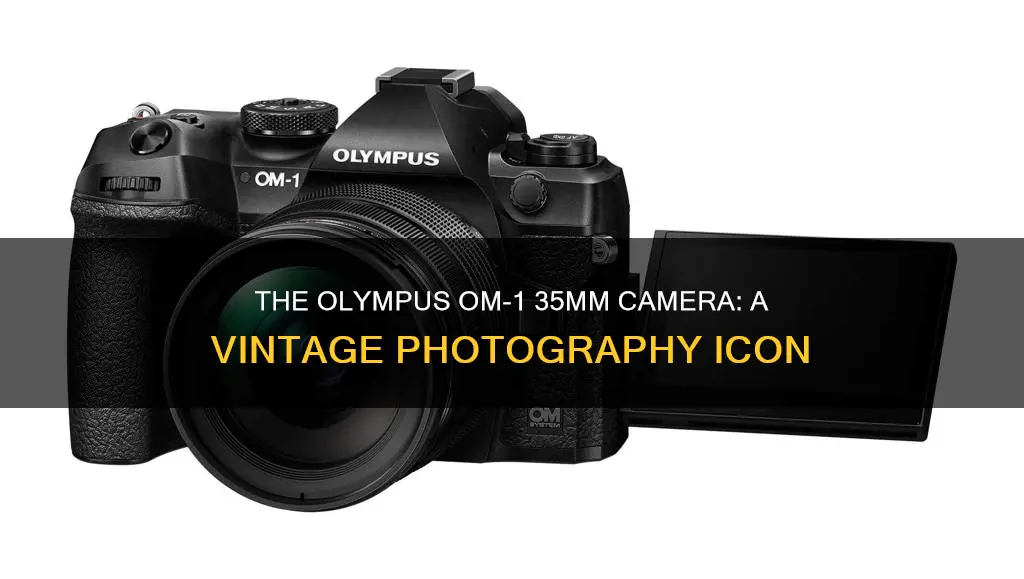
The Olympus OM-1 is a manually operated 35mm single-lens reflex camera, which was first introduced in 1972 as the M-1. It was the first product in the OM Series and was widely acclaimed as the world's smallest and lightest 35mm single-lens reflex camera. The camera was designed by a team led by Yoshihisa Maitani and was an important innovation in the history of 35mm SLR cameras, setting a new standard for compactness and lightweight design.
| Characteristics | Values |
|---|---|
| Year of Launch | 1972 |
| Original Name | M-1 |
| Reason for Name Change | Leica's flagship rangefinder cameras are known as the M Series |
| Designer | Yoshihisa Maitani |
| Type of Camera | 35mm single-lens reflex camera |
| Type of Shutter | Cloth curtain shutter |
| Shutter Speed | 1 second to 1/1000 |
| Shutter Durability | 100,000 operations |
| Light Meter | In-camera light meter |
| Size | 5.25 inches long and just over one pound |
| Battery | 625a battery |
What You'll Learn

The Olympus OM-1 was released in 1972
The OM-1 was unveiled at the 1972 Photokina in Cologne, Germany, and it immediately stood out. Designed by a team led by Yoshihisa Maitani, the OM-1 was the world's smallest and lightest 35mm single-lens reflex camera at the time. This compactness was achieved through innovative engineering, such as relocating core functions to less crowded parts of the camera body. For example, the shutter speed selector was placed around the lens mount, contributing to the camera's overall sleek design.
The camera's compact size and full complement of excellent glass made the OM-1 a top choice for travel photographers. Its mechanical design was highly durable, with a shutter assembly capable of 100,000 cycles, and it featured a large, bright viewfinder with interchangeable screens. The OM-1 also had a through-the-lens exposure meter, a self-timer, and a removable hot shoe.
The Olympus OM-1 was originally named the "M-1," but Leica requested a name change to avoid confusion with their M-Series. This led to the creation of the iconic "OM-1" moniker, which has since been revived for the latest Olympus mirrorless camera body.
The OM-1's release in 1972 not only cemented its own place in history but also set a new standard for camera design, influencing the development of 35mm SLR cameras for decades to come.
Capturing Sports Action: Keeping Your Camera in Sports Mode
You may want to see also

It was the world's smallest and lightest 35mm single-lens reflex camera
The Olympus OM-1 was introduced in 1972 as the first product in the OM Series. It was the world's smallest and lightest 35mm single-lens reflex camera, earning wide acclaim for its compact and lightweight design.
The OM-1 was a groundbreaking camera that revolutionised the 35mm SLR market. Prior to its release, the Nikon F had set the standard for professional photographers, but its large and bulky design drove the industry towards heavier and more cumbersome cameras. Olympus challenged this trend with the OM-1, which prioritised size and weight reduction without compromising performance.
The team led by designer Yoshihisa Maitani employed innovative ideas to reduce the camera's body size and improve shutter operation. They replaced the ribbons in the cloth curtain shutter with strings and incorporated an air damper to absorb the shock of mirror movement. The condenser was eliminated, and a pentaprism with a curved lower surface was utilised. Olympus also developed rust prevention technology for steel materials to further reduce the camera's weight.
The OM-1's compact dimensions made it an ideal choice for travel photographers. Its small size and full complement of excellent glass lenses made it a top pick for photographers on the go. The camera's portability, coupled with its advanced features and durability, solidified its reputation as a versatile and reliable tool for capturing memories.
The Olympus OM-1 was not just a technological marvel; it was a work of art. Its sleek and stylish design captivated photographers and enthusiasts alike. The camera's aesthetic appeal, combined with its functionality, created a cult-like following, with many collectors seeking out the original M-1 models that were produced before the name change to OM-1 at Leica's request.
In summary, the Olympus OM-1 was a landmark camera that reshaped the 35mm SLR landscape. Its introduction as the world's smallest and lightest 35mm single-lens reflex camera set a new standard for size and weight, inspiring a generation of photographers with its performance, portability, and timeless design.
Best Cameras Compatible with the Sony NP-BX1 Battery
You may want to see also

The OM-1 was originally named the M-1
The Olympus OM-1 was groundbreaking as it was the world's smallest and lightest 35mm single-lens reflex camera at the time. Olympus employed innovative techniques to reduce the camera's body size, as well as the noise and shock caused by shutter operation. The ribbons in the cloth curtain shutter were replaced with strings, and an air damper was added to absorb the shock of mirror movement. The OM-1 also featured a pentaprism with a curved lower surface, eliminating the need for a condenser.
The original M-1 is now a rare collector's item, with only 52,000 bodies produced according to Olympus. The camera's compact size and innovative features made it a popular choice for professional photographers, including Patrick Lichfield, Jane Bown, and David Bailey. The OM-1 was also known for its large viewfinder with interchangeable screens, a fixed prism, and a through-the-lens exposure meter. The shutter speed dial was conveniently located around the lens mount, making it easier for photographers to adjust settings while keeping the camera at their eye.
Crafting Fujifilm Cameras: An Insightful Look at Manufacturing
You may want to see also

The OM-1 is an all-mechanical SLR
The Olympus OM-1 is a 35mm film camera introduced in 1972. It was the first product in the OM Series and was widely acclaimed as the world's smallest and lightest 35mm single-lens reflex camera. The OM-1 is an all-mechanical SLR with a compact body, weighing in at just 510g. It has a large viewfinder with interchangeable screens and a fixed prism. The shutter speed dial is located around the lens mount, allowing for easy access between shots.
One of the most notable features of the OM-1 is its size. Olympus employed innovative ideas to reduce the body size and weight of the camera, making it much more compact and portable than other SLRs on the market at the time. This made it a popular choice for travel photographers and anyone looking for a more lightweight option.
Another key feature of the OM-1 is its durability. Olympus used rust prevention technology and heat treatment to maximize the durability of the steel materials used in the camera's construction. The shutter was also designed to be highly durable, with a system capable of withstanding 100,000 operations.
In terms of functionality, the OM-1 has a through-the-lens exposure meter that controls a needle visible in the viewfinder, assisting with exposure reading. The camera uses a 625a battery but can also be used without one, as everything except the light meter works perfectly without power. The OM-1 shoots on 135 film and has a self-timer and rewind switch located to the left of the lens.
The Olympus OM-1 is a highly sought-after camera, known for its compact size, lightweight design, and smooth operation. It is a favourite among photography enthusiasts and collectors alike, with its sleek vintage design and mechanical perfection making it a true classic in the world of film cameras.
Mastering Adjustment Brush Undo in Camera Raw
You may want to see also

The OM-1 is a good choice for new and semi-professional photographers
The Olympus OM-1 is a 35mm film camera introduced in 1972 as the first product in the OM Series. It is a compact, lightweight, and easy to use camera, making it an excellent choice for new and semi-professional photographers. Here are some reasons why the OM-1 is a good option for those looking to get into photography or upgrade their existing equipment:
Ease of Use and Portability:
- The OM-1 is known for its compact size and lightweight design, making it easy to carry around and travel with. It can easily fit into a purse or camera bag without adding too much bulk.
- The camera is designed with ergonomics in mind, allowing for easy one-handed adjustments to shutter speed, aperture, and other settings. All the controls are within easy reach, making it simple to adjust settings on the fly.
- The OM-1 has a large, bright viewfinder that makes it easy to compose shots and check exposure. The exposure needle is simple to use and visible through the viewfinder.
- The camera is equipped with a light meter, which some photographers prefer over carrying separate equipment.
Image Quality and Performance:
- The OM-1 is an all-mechanical camera with a reliable and precise design. It has a sturdy build quality and is known for its durability.
- The OM-1 offers a range of shutter speeds, from bulb setting to 1/1000 of a second, giving photographers flexibility in capturing fast-moving subjects or low-light scenes.
- The Zuiko lenses that came with the OM-1 are highly regarded for their optical quality and compact size. There is a wide range of lenses available in the OM system, providing photographers with various options for different types of photography.
- The OM-1 has a fast shutter release, and the lens focuses quickly and accurately.
Affordability and Value:
- The OM-1 is affordable, especially when compared to other cameras in its class. It is possible to find a good condition OM-1 with a quality lens for a reasonable price.
- The OM-1 provides excellent value for money, offering professional-level features and image quality at a lower cost than many other cameras on the market.
In summary, the Olympus OM-1 is an excellent choice for new and semi-professional photographers due to its ease of use, portability, image quality, and affordability. It offers a versatile set of features that cater to a wide range of photography styles and skill levels. The OM-1's combination of performance, durability, and value makes it a camera that can grow with photographers as they develop their skills and explore different photographic opportunities.
Reducing Grain in Camera Raw: Tips for Sharper Photos
You may want to see also
Frequently asked questions
The Olympus OM-1 was introduced in 1972 and was the first product in the OM Series.
The OM-1 was the world's smallest and lightest 35mm single-lens reflex camera at the time. It was also one of the most advanced cameras on the market, with a compact body, a large viewfinder, and a light meter.
The first model was presented as the Olympus M-1 at photokina in Cologne in 1972. However, Leica, whose flagship rangefinder cameras are known as the M Series, asked Olympus to change the name to avoid confusion.
The Olympus OM-1 was designed by a team led by Yoshihisa Maitani, who had previously created the Pen and Pen F cameras, which were also known for their compactness.







